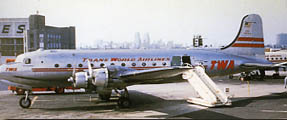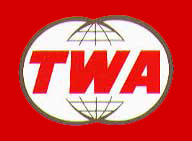Those Amazing TWA Flying Machines

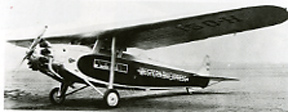 The 1926 Fokker
The 1926 Fokker
In 1926 Western Air Express spent its entire $180,000 to purchase three Fokker F10 tri-motors. With three Pratt & Whitney Wasp engines; it could maintain altitude with only one engine, and could climb to 7,000 feet with two engines. The F-10 had wheel brakes, a lavatory, a lighted instrument panel and “full cabin-length windows” that could be opened in flight to let in the fresh air.
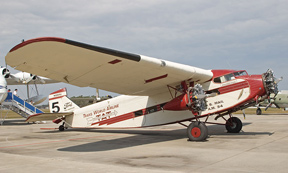 The 1926 Ford Tri-Motor
The 1926 Ford Tri-Motor
An All -metal Airplane. This aircraft was to become standard equipment in early aviation history. The great Ford Motor Company - Diesel Ford himself-opened an airport and a manufacturing plant at Dearborn, Michigan in 1924. The airport was the first in history with two paved runways. After a couple of prototypes, June 11, 1926 the first official Ford Tri-Motor rolled out onto the runway and flew into aviation history.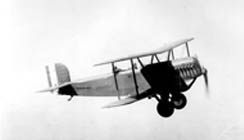
The 1926 Douglas M-2
Primarily a mail carrier, the Douglas machine was probably the best design in its day for its designated task. The mail compartment, in front of the pilot’s cockpit, was sealed off from the engine by a fireproof wall. This two man cockpit was one of 57 aircraft built, and became the beginnings of Western Air Express (eventually to transition to TWA).
 July 1933 DC -1 Development of the DC-1 can be traced back to the 1931 crash of TWA Flight 599, which was caused by a Fokker F.10 Trimotor airliner suffering a structural failure of one of its wings, probably due to water which had over time seeped between the layers of the wood laminate and dissolved the glue holding the layers together. Famed coach Knute Rockne died in that crash March 31, 1931. The DC-1 was a dream plane designed by Jack Frye, Paul Richter, Walt Hamilton and Tommy Tomlinson (TWA pilot). TWA created a wish list of the idea aircraft design. TWA asked five manufacturers to bid for construction of a three-engined, 12-seat aircraft of all-metal construction, capable of flying 1,080 mi (1,740 km) at 150 mph (242 km/h). The most demanding part of the specification was that the airliner would have to be capable of safely taking off from any airport on TWA's main routes (and in particular Albuquerque, at high altitude and with severe summer temperatures) with one engine non-functioning.
July 1933 DC -1 Development of the DC-1 can be traced back to the 1931 crash of TWA Flight 599, which was caused by a Fokker F.10 Trimotor airliner suffering a structural failure of one of its wings, probably due to water which had over time seeped between the layers of the wood laminate and dissolved the glue holding the layers together. Famed coach Knute Rockne died in that crash March 31, 1931. The DC-1 was a dream plane designed by Jack Frye, Paul Richter, Walt Hamilton and Tommy Tomlinson (TWA pilot). TWA created a wish list of the idea aircraft design. TWA asked five manufacturers to bid for construction of a three-engined, 12-seat aircraft of all-metal construction, capable of flying 1,080 mi (1,740 km) at 150 mph (242 km/h). The most demanding part of the specification was that the airliner would have to be capable of safely taking off from any airport on TWA's main routes (and in particular Albuquerque, at high altitude and with severe summer temperatures) with one engine non-functioning.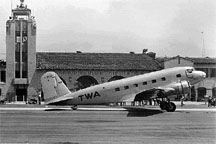
Donald Douglas was initially reluctant to participate in the invitation from TWA. He doubted that there would be a market for 100 aircraft, the number of sales necessary to cover development costs. Nevertheless, he submitted a design consisting of an all-metal, low-wing, twin-engined aircraft seating 12 passengers, a crew of two and a flight attendant. The aircraft exceeded the specifications of TWA even with two engines. It was insulated against noise, heated, and fully capable of both flying and performing a controlled takeoff or landing on one engine. Only one proto-type, but this design became the workhorse of the airline industry and changed flying forever.
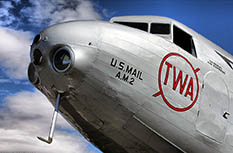 1933 Douglas DC-2 The DC-2, was a first of its kind for comfortable passenger transportation.
1933 Douglas DC-2 The DC-2, was a first of its kind for comfortable passenger transportation. 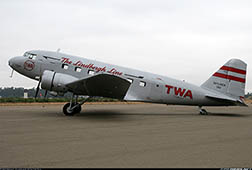 This aircraft could accommodate 14 passengers, one air hostess, two pilots. A new era of airline service began.
This aircraft could accommodate 14 passengers, one air hostess, two pilots. A new era of airline service began.
The DC-3 eventually became the workhorse of the skies. Many are still in use today.
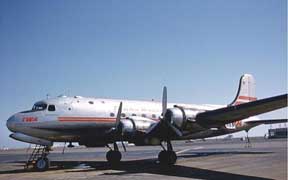
1930’s DC-3 The Douglas DC-3 cruise speed (207 mph (333 km/h) and range (1,500 mi (2,400 km)) revolutionized air transport in the 1930s and 1940s. Its lasting effect on the airline industry and World War II makes it one of the most significant transport aircraft ever made.
1940's DC4
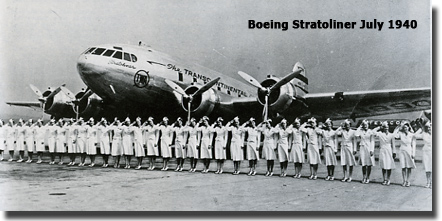 1942 Boeing Stratoliner February 14, 1942 the Boeing Stratoliner was the first pressurized cabin aircraft to TWA’s fleet. The Stratoliner carried 33 passengers during the daytime, then converted to night operation providing sixteen berths, and nine chaise lounge chairs. This aircraft could travel coast to coast in fourteen hours, was staffed by two hostesses. The Boeing Model 307 Stratoliner was the first commercial transport aircraft to enter service with a pressurized cabin.
1942 Boeing Stratoliner February 14, 1942 the Boeing Stratoliner was the first pressurized cabin aircraft to TWA’s fleet. The Stratoliner carried 33 passengers during the daytime, then converted to night operation providing sixteen berths, and nine chaise lounge chairs. This aircraft could travel coast to coast in fourteen hours, was staffed by two hostesses. The Boeing Model 307 Stratoliner was the first commercial transport aircraft to enter service with a pressurized cabin. 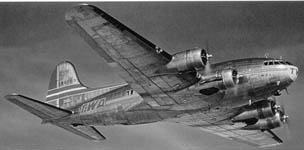 This feature allowed the aircraft to cruise at an altitude of 20,000 ft (6,000 m), well above many weather disturbances. The pressure differential was 2.5 psi (17 kPa), so at 14,700 ft (4,480 m) the cabin altitude was 8,000 ft (2,440 m). The Model 307 had capacity for a crew of five and 33 passengers. The cabin was nearly 12 ft (3.6 m) across. It was the first land-based aircraft to include a flight engineer as a crew member (several flying boats had included a flight engineer position earlier). Ten Stratoliners were built. Howard Huges bought one, Pan Am bought 5 and TWA bought 4.
This feature allowed the aircraft to cruise at an altitude of 20,000 ft (6,000 m), well above many weather disturbances. The pressure differential was 2.5 psi (17 kPa), so at 14,700 ft (4,480 m) the cabin altitude was 8,000 ft (2,440 m). The Model 307 had capacity for a crew of five and 33 passengers. The cabin was nearly 12 ft (3.6 m) across. It was the first land-based aircraft to include a flight engineer as a crew member (several flying boats had included a flight engineer position earlier). Ten Stratoliners were built. Howard Huges bought one, Pan Am bought 5 and TWA bought 4.
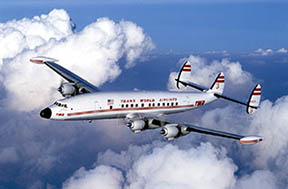 1944 Constellation 1944 the first production model of the Lockheel Constellation, “ Connie” debuted. this four-engine transport was capable of flying 57 passengers non-stop coast-to-coast above the weather in eight and a half hours. TWA (Jack Frye, Paul Richter, Howard Hughes) designed this state of art aircraft. While WWII was still in progress, Jack Frye and Howard Hughes flew the TWA’s first constellation from Burbank, California to Washington D.C. where they turned the A/C over the the Air Transport command. They arrived in the nation’s capital in a startling record time of six hours, 37 minutes. Here is a great YouTube video about TWA’s Constellation, Enjoy! Video - TWA Constellation
1944 Constellation 1944 the first production model of the Lockheel Constellation, “ Connie” debuted. this four-engine transport was capable of flying 57 passengers non-stop coast-to-coast above the weather in eight and a half hours. TWA (Jack Frye, Paul Richter, Howard Hughes) designed this state of art aircraft. While WWII was still in progress, Jack Frye and Howard Hughes flew the TWA’s first constellation from Burbank, California to Washington D.C. where they turned the A/C over the the Air Transport command. They arrived in the nation’s capital in a startling record time of six hours, 37 minutes. Here is a great YouTube video about TWA’s Constellation, Enjoy! Video - TWA Constellation

